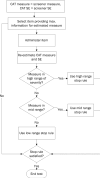Relative precision, efficiency and construct validity of different starting and stopping rules for a computerized adaptive test: the GAIN substance problem scale
- PMID: 17215565
- PMCID: PMC5933849
Relative precision, efficiency and construct validity of different starting and stopping rules for a computerized adaptive test: the GAIN substance problem scale
Abstract
Substance abuse treatment programs are being pressed to measure and make clinical decisions more efficiently about an increasing array of problems. This computerized adaptive testing (CAT) simulation examined the relative efficiency, precision and construct validity of different starting and stopping rules used to shorten the Global Appraisal of Individual Needs' (GAIN) Substance Problem Scale (SPS) and facilitate diagnosis based on it. Data came from 1,048 adolescents and adults referred to substance abuse treatment centers in 5 sites. CAT performance was evaluated using: (1) average standard errors, (2) average number of items, (3) bias in person measures, (4) root mean squared error of person measures, (5) Cohen's kappa to evaluate CAT classification compared to clinical classification, (6) correlation between CAT and full-scale measures, and (7) construct validity of CAT classification vs. clinical classification using correlations with five theoretically associated instruments. Results supported both CAT efficiency and validity.
Figures



Similar articles
-
Optimizing measurement of vision-related quality of life: a computerized adaptive test for the impact of vision impairment questionnaire (IVI-CAT).Qual Life Res. 2020 Mar;29(3):765-774. doi: 10.1007/s11136-019-02354-y. Epub 2019 Nov 9. Qual Life Res. 2020. PMID: 31707693
-
Measurement Precision and Efficiency of Computerized Adaptive Testing for the Activities-specific Balance Confidence Scale in People With Stroke.Phys Ther. 2021 Apr 4;101(4):pzab020. doi: 10.1093/ptj/pzab020. Phys Ther. 2021. PMID: 33481989 Free PMC article.
-
Development of a computerized adaptive substance use disorder scale for screening and measurement: the CAT-SUD.Addiction. 2020 Jul;115(7):1382-1394. doi: 10.1111/add.14938. Epub 2020 Jan 14. Addiction. 2020. PMID: 31943486 Free PMC article.
-
[Psychometric characteristics of questionnaires designed to assess the knowledge, perceptions and practices of health care professionals with regards to alcoholic patients].Encephale. 2004 Sep-Oct;30(5):437-46. doi: 10.1016/s0013-7006(04)95458-9. Encephale. 2004. PMID: 15627048 Review. French.
-
Assessing adolescent substance use: a critique of current measurement instruments.J Subst Abuse Treat. 1994 Nov-Dec;11(6):553-63. doi: 10.1016/0740-5472(94)90007-8. J Subst Abuse Treat. 1994. PMID: 7884839 Review.
Cited by
-
Substance use disorder symptoms: evidence of differential item functioning by age.J Appl Meas. 2007;8(4):373-87. J Appl Meas. 2007. PMID: 18250524 Free PMC article.
-
Rasch model of the GAIN substance problem scale among inpatient and outpatient clients in the city of São Paulo, Brazil.Addict Behav Rep. 2015 Aug 28;2:55-60. doi: 10.1016/j.abrep.2015.08.001. eCollection 2015 Dec. Addict Behav Rep. 2015. PMID: 29531994 Free PMC article.
-
Early COVID-Related pandemic impacts and subsequent opioid outcomes among persons receiving medication for opioid use disorder: a secondary data analysis of a Type-3 hybrid trial.Addict Sci Clin Pract. 2023 Sep 13;18(1):54. doi: 10.1186/s13722-023-00409-7. Addict Sci Clin Pract. 2023. PMID: 37705105 Free PMC article.
-
Stopping Rules for Computer Adaptive Testing When Item Banks Have Nonuniform Information.Int J Test. 2020;20(2):146-168. Epub 2019 Jul 16. Int J Test. 2020. PMID: 32982603 Free PMC article.
-
Persons from racial and ethnic minority groups receiving medication for opioid use disorder experienced increased difficulty accessing harm reduction services during COVID-19.J Subst Abuse Treat. 2022 Jan;132:108648. doi: 10.1016/j.jsat.2021.108648. Epub 2021 Oct 30. J Subst Abuse Treat. 2022. PMID: 34742607 Free PMC article. Clinical Trial.
References
-
- Alexander JE, Davidoff DA. Psychological testing, computers and aging. Journal of Technology and Aging. 1990;3:47–56.
-
- American Psychiatric Association. Diagnostic and statistical manual of mental disorders DSM IV-TR. 4. Washington DC: American Psychiatric Association; 1994.
-
- American Psychiatric Association. Diagnostic and statistical manual of mental disorders (DSM-IV-TR) 4. Washington DC: American Psychiatric Association; 2000.
-
- American Society of Addiction Medicine (ASAM) Patient placement criteria for the treatment for substance-related disorders. 2. Chevy Chase, MD: American Society of Addiction Medicine; 2001.
-
- Andrich D. A rating formulation for ordered response categories. Psychometrika. 1978;43:561–573.
Publication types
MeSH terms
Grants and funding
LinkOut - more resources
Full Text Sources
Medical
Miscellaneous
